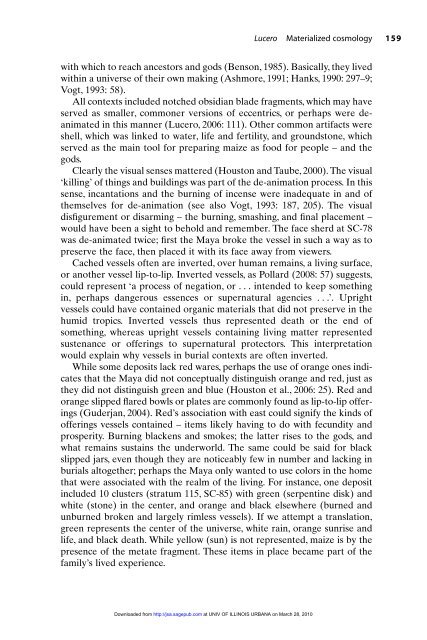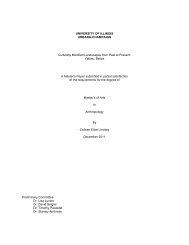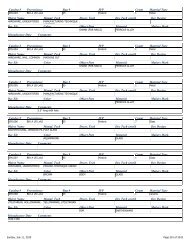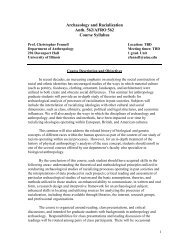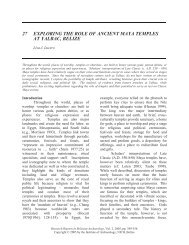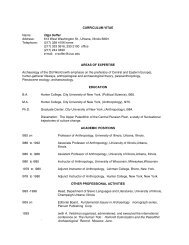Materialized Cosmology among Ancient Maya Commoners.
Materialized Cosmology among Ancient Maya Commoners.
Materialized Cosmology among Ancient Maya Commoners.
Create successful ePaper yourself
Turn your PDF publications into a flip-book with our unique Google optimized e-Paper software.
Lucero<strong>Materialized</strong> cosmology159with which to reach ancestors and gods (Benson, 1985). Basically, they livedwithin a universe of their own making (Ashmore, 1991; Hanks, 1990: 297–9;Vogt, 1993: 58).All contexts included notched obsidian blade fragments, which may haveserved as smaller, commoner versions of eccentrics, or perhaps were deanimatedin this manner (Lucero, 2006: 111). Other common artifacts wereshell, which was linked to water, life and fertility, and groundstone, whichserved as the main tool for preparing maize as food for people – and thegods.Clearly the visual senses mattered (Houston and Taube, 2000). The visual‘killing’ of things and buildings was part of the de-animation process. In thissense, incantations and the burning of incense were inadequate in and ofthemselves for de-animation (see also Vogt, 1993: 187, 205). The visualdisfigurement or disarming – the burning, smashing, and final placement –would have been a sight to behold and remember. The face sherd at SC-78was de-animated twice; first the <strong>Maya</strong> broke the vessel in such a way as topreserve the face, then placed it with its face away from viewers.Cached vessels often are inverted, over human remains, a living surface,or another vessel lip-to-lip. Inverted vessels, as Pollard (2008: 57) suggests,could represent ‘a process of negation, or . . . intended to keep somethingin, perhaps dangerous essences or supernatural agencies . . .’. Uprightvessels could have contained organic materials that did not preserve in thehumid tropics. Inverted vessels thus represented death or the end ofsomething, whereas upright vessels containing living matter representedsustenance or offerings to supernatural protectors. This interpretationwould explain why vessels in burial contexts are often inverted.While some deposits lack red wares, perhaps the use of orange ones indicatesthat the <strong>Maya</strong> did not conceptually distinguish orange and red, just asthey did not distinguish green and blue (Houston et al., 2006: 25). Red andorange slipped flared bowls or plates are commonly found as lip-to-lip offerings(Guderjan, 2004). Red’s association with east could signify the kinds ofofferings vessels contained – items likely having to do with fecundity andprosperity. Burning blackens and smokes; the latter rises to the gods, andwhat remains sustains the underworld. The same could be said for blackslipped jars, even though they are noticeably few in number and lacking inburials altogether; perhaps the <strong>Maya</strong> only wanted to use colors in the homethat were associated with the realm of the living. For instance, one depositincluded 10 clusters (stratum 115, SC-85) with green (serpentine disk) andwhite (stone) in the center, and orange and black elsewhere (burned andunburned broken and largely rimless vessels). If we attempt a translation,green represents the center of the universe, white rain, orange sunrise andlife, and black death. While yellow (sun) is not represented, maize is by thepresence of the metate fragment. These items in place became part of thefamily’s lived experience.Downloaded from http://jsa.sagepub.com at UNIV OF ILLINOIS URBANA on March 28, 2010


